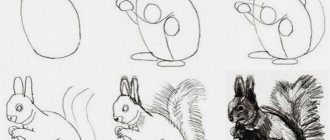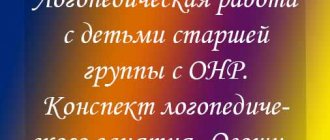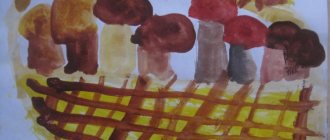MAGAZINE Preschooler.RF
Author: Litovkina Olga Nikolaevna, teacher of kindergarten No. 17 in Alekseevka, Belgorod region Goal: • teach children a new drawing technique - using food coloring, continue to teach the technique of monotype; create conditions for creative activity through the use of the principle of synesthesia (music, sounds of nature, aromatherapy), creating a game situation; fix the names of meadow and garden flowers; • develop creative imagination by guessing the image of meadow and garden flowers in color spots, promote the development of coherent speech in preschoolers; • cultivate emotional responsiveness to the beauty of the surrounding nature. Preliminary work: looking at reproductions of paintings depicting a blooming meadow, looking at postcards, photographs depicting garden and meadow flowers, talking about flowers, reading the story by K. Paustovsky “The Golden Meadow”. Materials and equipment: food dyes, watercolor paints, palettes, napkins, brushes large and small, A3 paper, sponges, jars of water, wet wipes, aroma lamp, lavender oil, bags and jars with dried herbs, magic wand, letter from a gnome , tape recorder, audio recording with music and sounds of nature. Move. 1. Organizational and surprise moment. The group one is designed like a clearing, but without flowers. A path of colored “stones” leads to the clearing. — Guys, look what a beautiful path we have in our group. Want to know where it leads? Then let's follow it. Children walk one after another along the path. They sit on a clearing rug. - Guys, where are we? That's right, this is a clearing. See what's growing here? Children find dried meadow herbs and smell them. - This is thyme, and this is lemon balm, mint, chamomile. Smell them. - What else should grow in the clearing? The children answer that flowers should grow in the clearing. -Where did they disappear to? Look, a gnome (large toy) has come to us. He is holding something in his hands. This is some kind of letter. Perhaps this letter is for us. Let's read it. The guys agree, and we read the letter: “Dear guys, many beautiful flowers used to grow in our meadow: lilies of the valley, daisies, dandelions, roses, cornflowers, bells. But one day, an evil witch bewitched all the flowers and they disappeared. In order for the flowers to appear again, you need to solve riddles. Help us please". The children agree to help, and I tell them riddles about flowers. Hey, bells, blue, with a tongue, but no bells! (Bells)The white cups look at the grass, smell fragrant, and stand on a stem. (Lilies of the valley)
Little sisters are standing in the field - yellow eyes, white eyelashes. (Chamomile)
The blue stars are burning in the field, They strive to jump right out of the rye. (Cornflowers)
The red princess grows in our garden, and she only drinks pure water. (Rose)
A ball grew on a green fragile leg near the path, a breeze rustled and scattered this ball. (Dandelion)
- What great fellows you are! We managed to solve all the riddles. But look around... Has anything changed? Have flowers appeared? The children conclude that the flowers never appeared. - Guys, look what else I found in the clearing? The children answer that the found object looks like a magic wand. - How did you know that she was magical? (Because she's beautiful). - By touching me with my magic wand, I can turn you into flowers. You, Tanya, will be a daisy! I will turn you, Nikita, into a dandelion, etc. Children depict flowers. — We have wonderful flowers! Guys, but I feel sorry for leaving you with flowers, so I’m turning you back into boys and girls. Let's think about how we can return flowers to the meadow with our own hands? Children offer various options. I lead the children to the idea that we can draw flowers.
2. Show the image method.
— First, let’s light a magic aroma lamp so that our group will be filled with the smells of flowers. And now I will teach you how to draw magic flowers. I take a piece of paper. I fold it in half. Then, using a sponge, I wet the sheet with water. With a thick brush, I paint half the sheet with colored spots of cheerful colors (I ask the children what colors they are). Then, until the sheet is dry, I scatter magic paints (food coloring). See how beautifully the dyes spread on a damp sheet, like stars. Now I fold the sheet in half. We count to three. I'm unfolding it. You get beautiful colored spots. Now this spot needs to be disenchanted. Think about what this blue spot looks like (like a cornflower, a bell). Draw a stem and leaves for it. Here is one flower that has already been disenchanted. Disenchant the rest of the flowers in the same way. Let the magic begin. And so that inspiration comes to you quickly, I will turn on music with the sounds of nature. Imagine that you are in a real summer meadow, the sun is shining, birds are singing, insects are buzzing... And while you are drawing, you can come up with some kind of fairy tale or story about your flowers.
3. Independent activity of children. Children draw on their own. If the child is at a loss, I pay attention to the similarity of a particular spot with a flower. I encourage timid children and praise them so that the children do not have the fear of failure in working with new visual material. After the children apply the food coloring and while it is drying, a physical education session is held.
The wind sways the butterflies, tilts them left and right. Once they bent down, twice they bent down, and they landed on the flowers. (2 times)
4. Analysis of children's works. - Guys, I see that you have already cast a spell on all the flowers. Now take them quickly to the clearing. Let us admire them. What colors did you use to paint? Tell us about your drawings. Who wants to tell a fairy tale about their flowers? (Children do self-analysis of their work). Did you like drawing this way? - You are so great, you managed to dispel the spell of the evil sorceress! Look what a beautiful clearing we have turned out to be, probably even more beautiful than it was before. There are bells, cornflowers, daisies, dandelions, and roses. In gratitude, the gnome has prepared gifts for you - these are such beautiful bags. Guess what's in them? To do this you need to touch and smell them. The children answer that the bags contain dry grass. - Yes, guys, these are dry medicinal herbs and flowers. Now you can enjoy the smell of a blooming meadow all year round.
| Next > |
Drawing lesson in the senior group. Flowers using stained glass technique
Flower drawing lesson in kindergarten
Master class on painting “Flowers” using stained glass technique
Author: Tatyana Gennadievna Borodina, teacher of the senior group of State Budget Educational Institution Secondary School No. 289 (kindergarten No. 1867) in Moscow. Purpose of the work: the master class is intended for educators, children of senior preschool age, parents and teachers of additional education of artistic and aesthetic orientation. The drawing can be used to decorate the interior of a group or kindergarten locker room. Goal: Create a drawing “Flowers” using stained glass technique. Introducing children of senior preschool age to an unconventional drawing technique - stained glass painting. Tasks: - continue to teach children to work with gouache paints; - develop a sense of color, creative imagination, thinking, imagination - cultivate interest in creativity and accuracy in work. Flowers give us a good mood, And awaken inspiration, As a symbol of pure beauty, After all, it is very difficult without a dream! And remains firmly with us, Everything that is connected with flowers, The colors of the stars dissolved in them, And a world of love without torment and tears! Mark Lvovsky Materials: white thick sheet of A2 paper, simple pencil, eraser, gouache paints, pony brush No. 2 and No. 4, water glass, black bold marker, A2 picture frame.
Progress
1. Draw the first flower with a simple pencil.
2. Draw a second flower of the same size.
3. Sketch the third flower.
4. Draw the fourth and fifth smaller flowers.
5. Draw petals from large flowers.
6. Make “stained glass” lines with a pencil.
7. Take red gouache paints and paint the first flower.
8. Color the second flower in the same way.
9. The third flower can be painted lilac.
10. Color the fourth and fifth flowers with orange paint.
11. Paint the centers of all flowers blue.
12. Paint the leaves with green gouache.
13. We make “outlines” for the stained glass pieces using different gouache colors.
14. We first paint the “pieces of glass” with yellow and orange.
15. Next, decorate with blue and purple.
16. Putting the finishing touches on the flowers.
17. Take a black bold marker and trace the outline of the flowers and leaves.
18. We trace the “pieces of glass” along the pencil line with a marker.
19. We got such a beautiful picture. “If spring comes to us, And it hurts with melancholy, This is the painting of nature, The light of her prayers.”
20. Insert the picture into the frame.
21. We hang a picture on the wall.
The picture serves as a wonderful decoration for the group!
22. These are the two wonderful pictures we got. I painted one picture, and the second was painted collectively with the children.
Thank you for your attention. I wish everyone inspiration and creative success!
We recommend watching:
Lesson on drawing autumn flowers with watercolors and wax crayons for children 7-10 years old Introductory lesson for children 7 years old according to the program of artistic and aesthetic orientation How to draw asters in a vase Non-traditional drawing at school on the topic: Summer
Similar articles:
Drawing daisies. Master Class
Drawing flowers. Master Class
Summary of GCD for drawing in the middle group “Beautiful Flowers”
Daria Rimshan
Summary of GCD for drawing in the middle group “Beautiful Flowers”
Abstract of GCD for HER ( drawing )
in
the middle group
on the topic: “ Beautiful flowers ”
.
Goal: to consolidate children’s ideas about flowers (their structure, classification, develop the ability to draw flowers , using different techniques and unconventional forms of drawing (crumpled paper)
.
1. Continue to form children’s understanding of flowers , their structure, classification, teach children to draw flowers using non-traditional forms ( drawing with crumpled paper )
;
2. Continue to develop the ability to draw with different techniques (painting in different directions, drawing with the whole bristle and the end of the brush) and techniques ( drawing with crumpled paper , develop aesthetic feelings (children should carefully choose the color of paint , imagination, creativity;





